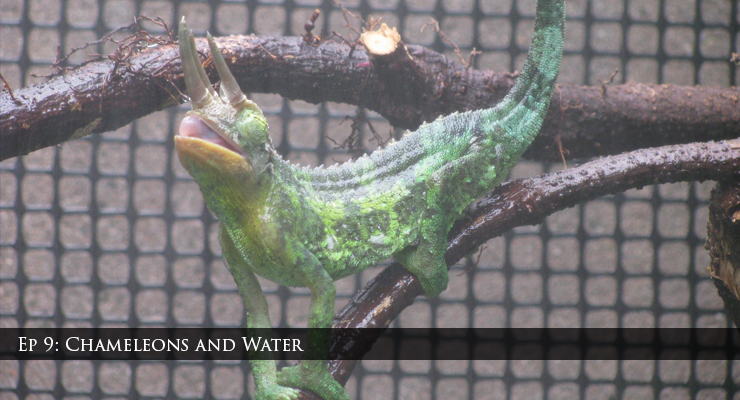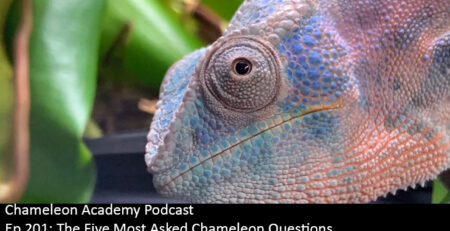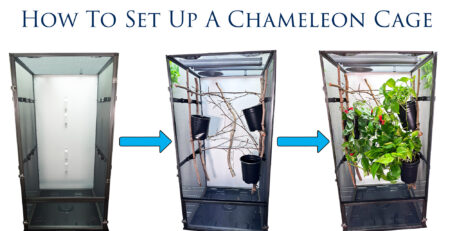Ep 9: Chameleons & Water
Summary: Today we are talking about water. Water is as important to chameleons as it is to us. They need it properly function. Hydration is the basis of all organ functions within the body and so I am probably stating the obvious when I say we must put a high priority on providing water in the correct form for our mini tree dragons.
Note: This episode was updated in April 2019 to include a more up to date approach to hydration. Many podcasts do not bother updating the past, but the Chameleon Breeder Podcast is meant to be a reference and, therefore, it is worthwhile to update episodes. The main area of change is a shift in philosophy regarding eye health and showering. If it is your first time, do not worry about it and just listen on!
.
You can listen here:
Bill Strand
Chameleons & Water
We talk about a lot of products on this episode and I’ll provide links to where you can purchase these if you feel they are right for you. As an Amazon Associate I earn from qualifying purchases.
This podcast was all about watering methods for chameleons.
Dripper
The simplest was letting ice cubes melt and poking a hole in a cup for a slow drip. But there are professional grade drippers that can provide a low cost drip long after you go to work in the morning. Bonus points if you can get the drip to bounce off the leaves for drinking and then fall into the plant to water it!
Hand Sprayers
The next step up are hand sprayers. They can either be manual sprayers or pressure sprayers. The manual sprayer requires strong wrist muscles as each spray requires a trigger pull. A pressure sprayer allows you to pressurize the water basin and then the water will come out continuously when you hold the trigger down. Between the two, a pressure sprayer is definitely the way to go! Both manual sprayers and pressure sprayers will allow the chameleon both hydration and hygiene. Though to get to the hygiene part with a manual sprayer you will be developing some massive wrist muscles!
Pressure Sprayer with 2 liter capacity:
Pressure Sprayer with 1 liter capacity:
Chameleon Cantina
An innovative product is the Chameleon Cantina. While I don’t see this as rivaling a full misting system for effectiveness, this product can be a good way to hydrate your chameleon. Just make sure your chameleon recognizes the water and takes to it. Every chameleon will be different.
Fogger (Ultrasonic Humidifiers)
Ultrasonic foggers are available and help with humidity. You will have a visible cloud defending into your cage which has great aesthetic value. Keep these things clean though! You are aerosolizing and injecting into the breathing air everything in the water basin. Just make sure that basin is clean! I have had experience with a few of the commercially available ultrasonic humidifiers that are marketed towards reptile keepers.
The Oiibo product has been my favorite, though I did have wrong parts included and customer service is typical of off-shore suppliers (not good). But once it is working it works well. It has a Y attachment and two tubes that makes it convenient to place between two cages. This product has a 2L reservoir.
I’d like to try this next one as I appreciate the larger 3L reservoir, though you would need to create your own dispersement system if you wanted to provide for more than one cage.
And I have heard of keepers using the Evergreen product being happy with their result.
The Zoo-med ReptiFogger is an interesting fogger that uses a relatively small bottle reservoir. But I did try this myself and found it to work well.
Misting Systems
And we finally get to misting systems! Below is a chart with the Chameleon Breeder Podcast product comparison ratings.
[ultimatetables 1 /]
Key:
Price: How much it generally costs. Promotions will make price vary.
Timer:
Cycle timer = simple count down timer. You will need a separate appliance timer to make a unit with a Cycle Timer work well for chameleons.
Seconds timer = complete control of when mister goes on, which day, and for how long. Eight different misting cycle programming is standard.
Water Reservoir:
The water basin from which the pump draws it water. It is either Self-contained which means it is ready to go out of the box or else it is User Provided which means you will have to provide one.
Nozzles Included: How many nozzles are included in the base unit.
Dry Operation: How does the unit handle being run without water in the reservoir?
Expandability: How many nozzles can be added to the system
Mist Quality: How fine is the output?
Product Quality: What is the overall product quality reported back from users.
Recommendation: The Chameleon Breeder Podcast product ranking.
Zoo Med Repti-Rain
Summary: This mister is really a sprayer as it just doesn’t get the mist to be as fine as I would like. The awkward mounting and very small .25 water reservoir mean that I probably won’t be using this product much. Couple the design short comings with too many reports of poor quality and I will recommend this product only if you are unable to step up to the Monsoon. While the Exo-Terra Monsoon has its own quality issues, the Monsoon problems can be avoided. The Zoo Med Repti-Rain just breaks down and there is no way around that. It is listed here only because it is better than a dripper. It will give your chameleon a good spray of water while it is functional!
Exo-Terra Monsoon
I actually like this mister. It seems Exo-Terra did a 98% great job except for a 2% design issue which allows water into the control circuitry. Unfortunately, this results in 100% failure of the unit. Water short circuits the timer panel and the unit turns on and just keeps going until it empties whatever is left of the 2.5 gallon reservoir at which point the internal safety switch presumably turns on and stops the unit. Strangely enough, there is actually a simple fix to avoid that situation. You just use an appliance timer to control the power to the unit, fill up the reservoir with the lid off (don’t use the fill-up hole), and don’t fill the reservoir up all the way. That said, although I like this unit and it is working for me so far, I am nervous when such a major design problem is found. It shows an emphasis on making something cheap rather than making something good so I am wondering what else is waiting to fail. I hate to rain on this parade, but I am sad that such a good unit gives me an uneasy feeling about trusting it. But, as far as I know so far, bypassing the water intake and using an appliance timer makes up for the design shortcomings and you can have that fine mist for a lower price. This system is expandable to 6 nozzles and has a number of accessories so it well supported. Note that the motor makes a loud noise when it is on.
Exo-Terra also makes a one-cage version. I have not tested this product personally, but would make the assumption that the operation is similar to the large version. The pump is rated by Exo-Terra for two mist nozzles.
Mist King
Mist King has been the go-to Misting system for the serious chameleon hobbyist. The professional grade pump is powerful, relatively quiet, and produces a fine mist. This starter kit comes with one nozzle, but can be easily expanded. This system ties for my top choice for a mister for your chameleon. But note that there is no screen wedge in this starter pack. You have to order them separately. Don’t forget the wedges! Some starter packs will have misting wedges bundled in, but make sure they are there!
Cli-mist
The Cli-Mist misting system ties for top recommendation for your chameleon’s misting system. With fine mist, the precision of a seconds timer, and a line of accessories for expandability, this system will do the job. But remember that you have to order the screen wedges separately! Cli-Mist has been great about recognizing us chameleon keepers and they have, for years, offered a mounting wedge as a “free gift” when you buy one of their systems. Just make sure that this promotion is still in effect when you purchase your system!
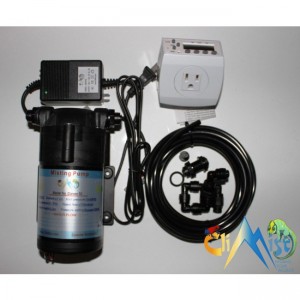
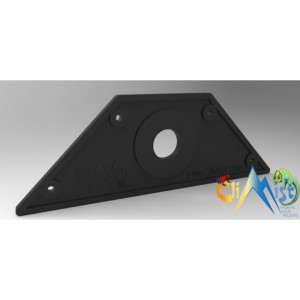
Dragon Strand Cages that retain mist
If you are looking for a cage which can keep mist inside the cage then the top of the line is the Dragon Strand Clearside Enclosure. It has three sides that are a clear lightweight PVC material and one side that is screen. This gives a balance between holding in the mist and giving ventilation.
If you have a screen cage and you would like to protect the sides from allowing mist through then wrap a bamboo mat around the walls and you’ll get a natural looking background.
Transcript (more or less)
Transcript (More or Less)
Note: The Chameleon Breeder Podcast changed the name to The Chameleon Academy Podcast in 2020. This ties together the outreach efforts that grew from this original podcast. Although the audio mentions the Chameleon Breeder name, the links here in the show notes have been updated.
Today we are talking about water. Water is as important to chameleons as it is to us. They need it properly function. Hydration is the basis of all organ functions within the body and so I am probably stating the obvious when I say we must put a high priority on providing water in the correct form for our mini tree dragons.
Good morning Chameleon Wranglers, Today’s episode starts with a note. This episode was updated in February 2019 to include a more up to date approach to hydration. Many podcasts do not bother updating the past, but the Chameleon Breeder Podcast is meant to be a reference and, therefore, it is worthwhile to update episodes. If this is your second time listening you are welcome to reference the show notes at chameleonbreeder.com episode 9 to learn about the changes. If it is your first time, do not worry about it and just listen on!
The Water Cycle
Chameleons have adapted to life in the trees and have become dependent on rain to drink. Although there are reports from the field of chameleons drinking from puddles or the bank side and some individuals have trained their chameleons to drink from standing water, this is not the most successful method across all chameleon species for obtaining water. We will focus on making life the easiest as possible for our chameleons and that means providing water in the form of moisture to be licked off leaves. In the wild, chameleons find water as condensation on leaves when they wake up in the morning as dew, and of course, when it rains. Moisture also comes to them with their food.
A 24 hour hydration cycle looks like this. If we start our 24 hour period at midnight our chameleon is sleeping in a high humidity night where moisture loss from breathing is minimized. When they wake up there is dew on the leaves which they lick. During the day they will also get moisture from the food they eat. And, of course, when it rains then water is all around. Annually, chameleons commonly get one or two wet seasons and then one or two dry seasons.
In captivity, everyone has a different approach to how they provide for the chameleon’s hydration needs. In our discussion here we will describe a simple protocol that is the easiest to implement and maintain.
If I were to pick one piece of hydration equipment that best supplied the basic hydration needs of a chameleon I would pick an automated misting system. With an automated misting system you will be able to simulate both a morning layer of dew and an afternoon rain shower.
In my opinion, the best watering system to start with is an automated misting system. This consists of a pump on a timer that drives misting heads on the cage. The mist heads create a blanket of mist on the surfaces and the timer ensures that it happens whether you remember or not or are even home or not. I would also suggest a dripper cup.
I would run the misters for about a minute before the lights come on in the morning to lay down that layer of dew. And then in the late evening, turn off your heat lamp, let the cage cool down for 15 to 30 minutes and then run the mister for a couple minutes.
If I can add another item I would add a dripper to be started in the morning after the lights have gone on. A dripper has the advantage that it can go on while the chameleon is awake and does not give them the rain signal which tells them to hunker down and wait out the storm. You’ll notice that your chameleon will avoid the mist and, when forced to be in it, will eventually settle into a nap like state until the rain is over with. They may drink during this afternoon rain storm.
For the ultimate hydration set-up, you can add a fogger to simulate the early morning fog rolling in like they are used to in the wild. This helps them sleep hydrated and not lose so much moisture during the night. I would run the fogger for a couple hours between 2AM and the lights coming on.
De-hydration has been an issue for the community for many years so do not doubt the importance of getting all this right!
With that basic format in mind, I’d like to review the various hydration methods commercially available and we can talk about how to use them. We will start from basic and work our way up to advanced.
Watering Methods
Ice cubes on cage top
One simple method that has been used is to simply place ice cubes on top of the screen cage and let the melting water drop onto the leaves. This provides a timed release of water. Although, the water is just above freezing when it drops. I am not a real fan of this because of the water temperature, but I know it works and I am trying to be comprehensive here. But please don’t rely on this method for hydration. I am going to suggest use it in emergency only.
Hole-in-a-cup
You can get a plastic party cup and poke a small hole in it with a pin. The resulting slow draining of water will provide a drip until the cup is empty. The more water the longer the drip. Although the more water, the heavier the cup and since you are putting downward weight on the screen of the top panel in a way that the screen panel was not designed to handle you need to tread carefully. Placing a grill or just two supports across the frame for the cup to sit on would solve this problem. This method is a cheap way to have a constant drip of water for hydration.
Commercial Dripper ($5 to $10)
You can find a commercial equivalent of the hole-in-a-cup strategy. These are called drippers and some have knobs which can adjust the drip flow. They aren’t expensive and even though a party cup is an easy do-it-yourself alternative I would suggest making sure your set-up looks clean and professional. At last that is my personal preference.
Hand Mister
Hand sprayers come in both manual and pressure spray versions. A manual version is the cheapest coming in around $3 to $7. It makes you squeeze the trigger for every spray while the pressure spray version allows you to pump to put the water under pressure. Then you just press a trigger to release your spray. The pressure spray version can be found from $10 to $50 depending on how big you want. You can get up to a backpack type unit if desired! The disadvantage of the hand sprayers is that you have to, every day, manually remember to provide hydration. You must have patience with this method and, if using the manual version, good wrist muscles.
Showering
Placing your chameleon in the shower has been a traditional method of rehydrating a chameleon. It has often been used to rehydrate imported chameleons. The attractive side of this is that there is a relatively endless supply of water. Just put a tree in the stall and you have an instant rain shower. Here are some considerations to make this work.
- Make sure the water is cool to your touch. This is supposed to be a rain shower. You don’t want to simulate an icy arctic storm, but, likewise, rain itself is not “warm”. I know we want them to be comfortable and we warm blooded humans love our warm showers! But remember that chameleons are cold blooded and not designed for warm showers. They are designed to be energized by the warmth of the sun and settled by the cool of the night – or rain. It is best to adhere to what they have been designed to expect.
- Some showers blast that water. For a chameleon size body that is like taking a fire hose to them. No matter how thirsty you are, a high pressure blast of water is not what is useful. We are not trying to pound water into them. We want a gentle rain that is relaxing and allows them to drink leisurely. Gentle is the important word here!
That said, I am no longer encouraging showers as a regular weekly or monthly hydration top off. Our goal is to create a cage environment that effectively supplies all needs, including hydration, within their cage. Instead of supplementing hydration outside the cage work on fixing the daily hydration cycle. If, for whatever reason, you do decide that a shower is necessary then just be careful about your temperatures and pressure.
Special Mention (Chameleon Cantina $24.99)
A relatively new and completely innovative product on the market is called the Chameleon Cantina. This small, pump based system creates a constant flow of water across some plastic leaves. Like every product I talk about in today’s episode, there is a picture and a link to this product in the show notes on the chameleonbreeder.com website. So, the Chameleon Cantina is a small water reservoir with a recirculating pump. The opening has a layer of plastic leaves that the water flows down. The opening is big enough for a chameleon to get their head in for drinking, but small enough that strategic placement can keep poop and feeder insects from getting in. It is essentially, a chameleon water fountain! If you decide to use this product then the most important thing is to make sure your chameleon is actually using it. Some chameleons take to it and some just don’t recognize it. When we come up with clever ways to give chameleons, heat, UVB, and water that they did not evolve to recognize we can end up patting ourselves on the back while our chameleons suffer and die. Make sure your particular chameleon figures out the concept of this drinking fountain. Don’t just put it in and go on vacation and don’t let it run out of water. The pump is not designed to run dry. You’ll burn that pump out. Mounting is a challenge. It comes with a suction cup for mounting which is completely useless for the typical screen cage. It was designed to go into a cage that this company makes which is marketed towards chameleons, but I…how can I say this…I suspect no live chameleons were actually involved in product testing. Anyway, you’ll have to find a creative way of mounting the cantina on the side of your cage. The electrical cord needs to go outside the cage. There is currently no easy way of doing this. One method is to loosen the frame screws and snake the power cord between the framing pieces. This gives an obvious opening in the cage for feeders to get out and whatever you have around the house to get in. Another method is to make a hole in the screen which, once again is not a clean option as you’ll have to plug that hole somehow. If you are handy with tools a bit you can get a small sheet of PVC or acrylic from the home improvement store. You can mount this to the inside of your cage from frame to frame. This gives an area for easy mounting of the Cantina and a method for covering up the screen hole for the power cord.
And finally, there is a carbon filter that is recommended to be replaced every month. The major consideration with this product and anytime you have water pooled or recirculated within the cage is cleanliness. You will have to keep on top of regular disinfection.
This product is not a 100% clean solution for us. I, personally, am not a huge fan of this, but I know some people have used it with success.
Foggers
Foggers, or ultrasonic humidifiers, are those devices that whip up water into a visible mist. They are highly appealing as it is beautiful watching the mist roll down. We used to consider them novelties, but an exposure to the concept of 24 hour hydration has elevated fogging from novelty to an integral part of everyday husbandry. Although this is a new concept only here in the US. Nighttime fogging has been used extensively by European breeders for years upon years and is such a basic component of husbandry that it is incredulous to them that we even debate it here in the US. And, on this, I must agree. It is mind blowing to me that we missed this all these years when we only have to think about what happens at night. Humidity rises and fog rolls in. To be fair, what we missed was not that it was happening, but the significance of it. We all thought hydration happened only when chameleons were awake and drinking. This was only half the story. An increase in nighttime humidity and a decrease during the day is the natural rhythm. Although we have proven that some species can reproduce with a backwards rhythm of heavy misting during the day and drying out during the night, it is folly to look at our success with easy to breed species like veileds and panthers and decide we have reached the pinnacle of husbandry. By getting closer and closer to natural conditions we will unlock greater successes with species we have failed at before. The fogging at night maintains their hydration during the sleep hours.
Fogging is best done during the very early morning hours before the lights come on. You are replicating the fog bank moving in which will get burned off with the morning sun.
Ultrasonic humidifiers are generally more useful to the chameleon keepers because they produce a directional fog. Regular humidifiers would work as well for this purpose, but then you are humidifying the entire room to between 70 to 100%. Houses generally are not designed for this, but if you rig up a directional feed or have a room where this can be accommodated then more power to you!
Ultra sonic humidifiers can be found easily online or in department stores. Some links are in the show notes, of course.
Ultra sonic humidifiers take a while to lay down a layer of dew so I like to use foggers in conjunction with misting systems. They make a powerful pair.
Now, Ultrasonic humidifiers have a couple of warnings attached. The first is a standard keep-it-clean issue. You are aerosolizing everything in the water and turning it into something that can be breathed in. That is the whole reason why it works as part of a hydration strategy during sleep. The ultrasonic process apparently does break down microorganisms to some extent, but it is hard to pin down just what it kills and what it distributes. The only clear thing that I can pass on is that the safety of the ultrasonic humidifiers depends on cleanliness. So avoid using ultrasonic humidifiers that require being inside the cage. Any open pool of water invites feeders, poop, and unexpected soiling.
Waterfall
Waterfalls have captured our imagination for centuries and one of the first things I thought of when I was putting together my first big cage construction was a nice long flow of water. It would be great for humidity and if I put leaves around it, a drinking source! Well, that part is absolutely correct! You can get these things from a waterfall. Unfortunately, along with that comes some unsavory elements. Most waterfalls are built around a water circulation system where the fallen water pools at the bottom and is brought back up to fall again. The problem comes with the cleanliness of the water. Water triggers a bowel vacating response in chameleons and they do a surprisingly good job getting it in the water receptacle. And then loose feeder insects have a habit of getting into the pool and drowning. All of this creates a bacterial nightmare which is then pumped back up. Most people, including myself, have concluded that the maintenance on fountains to keep them clean is more work than they are worth. I won’t discourage you from trying because maybe someone some day will figure it out. But if you are just starting out and wondering why we haven’t done something so obvious I just want to give you heads up that fountains have been struggled over for decades. If you are just starting out in this hobby then leave your aspirations to be the first successful fountain integrator until after you have all the other things figured out.
Misting Philosophies
A thirsty chameleon will drink
A drinking chameleon is not always thirsty (pipette)
Lets not torture the poor chameleons
The bulk of this discussion is centered around automatic misting systems. This is currently the hydration/hygiene method of choice. It provides water in the closest to rain form that we have presently. I firmly recommend adding an automatic misting system to your husbandry as it is by far the most reliable and effective method. But before we get into the actual products available, let’s talk about the misting session itself.
You might be surprised by the panic type reaction chameleons often give the first spray of water. The misters start and your chameleon’s first reaction is to react as if you have sprayed him with acid. It would be amusing if it didn’t look so painful. But let’s consider the situation. Chameleons are used to rain showers which have ample warning that they are arriving. The sky darkens, the barometric pressure changes, the temperature decreases (at least a little bit) and finally rain falls. In captivity, things tend to be a little more surprising. One moment all is clear and warm and the next minute relatively cold water is spraying all over the place. The first reaction of any animal when suddenly sprayed with water is to get away and chameleons do this, as well. So let’s make this as comfortable for your chameleon as possible.
A common misting strategy is to mist two times a day. We can make that first misting just a little bit before the lights come on in the morning. As your chameleon is asleep they won’t be shocked. But what this does is allows them to wake up in a world covered in dew. Then they can drink in a natural manner. The dew round only has to be long enough to give a nice layer of dew everywhere. If you feel it is important to have a longer session in the morning then arrange it so the overhead lights come on and leave the basking light off. Have your rain shower for as long as you wish and when it is over you can turn on the basking light so they can warm up.
The second round would simulate an afternoon rain shower and could happen in late afternoon. We can give the chameleon a warning by turning the basking lamp off. Not only do we not want to risk water hitting the hot bulb, but we are giving our chameleon clues as to what is about to come. If we establish a pattern of signs that a misting session will come soon your chameleon is smart enough to start getting himself where he wants to be during the rain shower. The most appropriate sign can be turning off the heat lamp. This simulates the clouds blocking the sun and the area cooling down a bit. This is pretty pitiful compared to the signs they get in the wild that rain is approaching, but chameleons are pretty smart and will be able to recognize simple patterns in their world.
Finally, the mist should be a gentle mist. Do not set up your misting system so it blasts your chameleon in the eyes, head, or body. If you bought a very powerful pump and have only one nozzle you might have an issue with spray strength. If necessary, you can siphon off some energy there by adding another nozzle or two that points to the soil where a plant is planted.
Product review of various misters.
There are a number of misters on the market and the prices vary from entry level to high end. The difference is really between $60 and $99 so both are affordable. You do get what you pay for in misters so when you are budgeting your chameleon husbandry items, budget your mister first. So I’ll start with entry level and we’ll move our way on up.
There are a number of characteristics that I’ll rate the misters on
1) Price. I have not always been so kind to some of the entry level misters in the market, but they have their place. The lower price may allow some chameleons to have mist instead of just drips and that is an increase in quality of life for the chameleon. In misters you get what you pay for, though. The low end misters are more accessible, but they are not as clean of an option. The higher end are a bit more complicated, but are powerful tools in husbandry so, if you can afford them, then it is well worth devoting the time to learn about them.
2) Timer. There are two types of timers used. The most economical is a cycle timer. This is where the timer has no idea what time it is. It merely counts down from when it was turned on. You are able to set how many hours between cycles and how long the cycle will last. As the units will turn on when power is applied you can just add an appliance timer to the power cord to control the unit. A seconds timer is a higher end option and has an internal clock that allows you to set precise times and durations for your misting sessions.
3) Water reservoir: There are two methods to holding water for the misters. Self-contained and user provided. Self-contained means that you will pour water into the misting unit itself. User provided means that you will be able to use whatever size container you would like, but it means you have to provide the container! Self-contained is useable out of the box. User Provided means you need to gather another piece to this puzzle.
4) Dry operation: What happens when the water is gone and the pump is turned on? What safety mechanisms are in place to make sure the unit does not burn out?
5) Expandability: How much can you expand the system?
Drip Loops
For all pumps you need to know about drip loops. There is always a chance of water splashing out when we fill the reservoir or one of those unseen events where water gets in contact with the power cord. It can then run down into the power socket creating a dangerous situation. You avoid this by making sure there is enough slack in the power cord so that the cord dips down and then up into the electrical socket. If you don’t understand what I am talking about look at the show notes and find the picture. If any water drips down the cord it will drip to the floor instead of flowing into the electrical socket.
Water type
Use distilled or RO water. Tap water has minerals in it which will clog your mist heads. If you do use tap water then you can clean out your mist heads with a vinegar bath. (the mist heads – not you)
Zoo-Med Repti-Rain
Price: Prone to promotion, price jumps around, but you can find them around $65.99
This is a cycle timer. You can choose between every hour, every three hours, 6 hours, and 12 hours and the duration can be set to 15, 30, 45, or 60 seconds each time.
You have a self-contained 28 ounce water reservoir – about a quarter gallon
Summary: The Repti-rain produces a spray more than a mist, but I have found the spray to be adequate for chameleons. If you are getting a stream of water adjust the nozzle head until it is as fine as you can go without shutting it off. It comes with two nozzles.
This automatic sprayer (we’ll call it) was designed for the Zoo Med terrariums and its mounting hardware is not really compatible with our screen cages. It has hooks for hanging and suction cups for sticking onto solid surfaces. The hooks are shown to work by hanging off the top frame of the screen cages, but one misalignment and they may go though your screen top. You can set it on a table, but there are vents on the bottom to avoid moisture build-up and that doesn’t sound like a good thing to block. There really is no solid mounting solution for us chameleon folk. I have used my test unit for a little while, but there are too many reports of quality issues for me to confidently recommend this unit. I’d rather you skip this one and get a mister you’ll be much happier with.
Exo-Terra Monsoon
Price is around $80. It comes with two mist heads.
This is a cycle timer with a bit more flexibility. You can choose between every hour, every 2,4,8,12,16, or 20 hours and the duration can be set to 2, 4, 8, 12, 16, 20, 30, 60, and 120 seconds each time. I recommend using an appliance timer and by passing the internal timer. There have been too many reported incidences of the timer getting moisture in it and giving out resulting in flooded cages to trust it at this time. Just use an external appliance timer on the power cord and you should avoid a nasty surprise.
You have a self-contained 2.5 gallon water reservoir on this unit.
Summary: I actually like this mister. It has enough pressure that you get a fine mist out. The large water reservoir is quite convenient. This unit will have to sit on a table, but you get eight feet of tubing extension. This system has a variety of accessories so it makes expansion to up to six nozzles pretty easy. I have not tried more than two nozzles so I can’t speak to how well it mists with the added load, though.
My biggest warning is that I have not heard that they have fixed their electronic problem where water gets into the timer circuitry. Some hobbyists have figured out that filling the tank while the top electronics portion is off and then being sure to not fill the water basin to the top takes care of the problem. I am suggesting taking those precautions and using an external appliance timer for your power control. The unit will turn on when power is applied so this is an effective control method.
It is loud, though. You will know when it turns on!
The Monsoon has an internal shut down when water is low so the pump does not overheat. Don’t rely on this, but it is good to know it is there.
The biggest problem we will have with the Monsoon is getting the nozzles in the cage. Once again we are forced to loosen cage walls or poke a hole through the screen. Not convenient. Many of you know I own the Dragon Strand Chameleon Caging company which I use to solve the caging problems I run across. I made a hydration mount which is a mounting solution that can be installed anywhere around the inside rim of the top panel. I actually made it with a hole that fits the two high end units we are about to go over and also a ¼” tubing hole. This ¼” tubing hole can be used to let the Monsoon mister in. You can buy these from dragonstrand.com or else, if you already have misting wedges laying around you can just drill a hole in it that is big enough for ¼” tubing to fit through. If you are not sure what I am talking about there is a link in the show notes that you can reference.
Let’s take a look at the High End
There are currently two high end misting system brands targeting the reptile market. There are numerous home misting systems for patios and such which you can use, but the easiest way to go is either Mist King or Cli-Mist.
Here are some common notes on both.
1) Both of these system use a Diaphragm Misting pump. These pumps are high power and can run dry without damage. Both of these require you to put together the system with couplings and tubing, but the power of these systems makes this effort well worthwhile.
2) Both require you to provide your own reservoir. This is the hardest part of the set-up as you must drill a hole in a water container and install a bulkhead which takes quite a bit of muscle. I, personally, just stick the intake tube down a 5 gallon jug of water. Their instructions say that the pump should be below the water line supplying it so, full disclosure, this strategy which I have been using for years is not recommended by the manufacturers and could be reducing the life of my pumps. Though here I am six years later still thumbing my nose at authority.
3) With diaphragm pumps they will sometimes need to be “burped”. When in use sometimes they just don’t have the umph they used to. And you just can’t figure out why it is not working. All the connections are correct, but you just get little spurts out. This usually happens if they, at some point, have run dry. Once they are running with out water then you need to essentially reset the water pressure. You do this by removing the water output line from the pump, run the pump so water comes out for a second, then reapply the output tubing. Your mister will now run well again. And don’t ask me why this works. It just does. I’ll figure out one day. But for now I am just happy it works.
4) Screen Wedges. These systems are the only ones that come with accessories specifically for mounting the nozzles on screen cages. This is the number 1 most forgotten accessory and source of frustration when you are ready to put everything together and realize that this piece is necessary and you don’t have it! Screen Wedges are a plastic wedge type shape that goes across the corner of the screen cage top panel, or in the case of the Dragon Strand mister mounts – anywhere along the edge of the frame- and allows you to mount the mist nozzle. You do have to poke a hole through the screen top, but the nut that holds the mister in place covers the jagged screen edges. I suggest installing the screen wedge on the inside of the top panel and if you can do the installation beforeyou put the cage together you are ahead of the game. Pushing self-tapping screws into an aluminum frame upside down has great potential for inappropriate language. If the cage is built, but there are no occupants yet then you can just turn the cage on its top. If there is already an occupant then take a deep breath and know that screws will fall a number of times before the night is over, but it can be done.
5) Both systems run off of ¼” tubing which can be found at any home improvement store if you need more. Look for the drip system area and you’ll find large rolls of it.
6) Both systems come with seconds timer which gives you down to the second control. These are wonderful timers.
Mist King
The starter system comes in at $129 and contains almost all you need and one misting nozzle. It can be expanding up to 10 nozzles. The only thing it does not come with is a screen wedge. Don’t forget to order this! There are a huge number of nozzles and fittings and accessories you can buy for this system. I have personally used Mist King for years now and it has served me well. I would recommend this system without hesitation. There are upgrade systems available which can be found on their website. Links are in the show notes
Cli-Mist
The starter system, called the CliMist Cyclone Misting system, starts at $149, but promotions can see it down to $99. This one expands to ten nozzles and some promotions have the screen wedge included free of charge. It appears Cli-Mist has taken notice of us chameleon people! I have used CliMist for many years and it is a good system. They have a more powerful system if you want to run a room. And links for that are, you guessed it, in the show notes.
Application
Okay, so we figured out our misting system. Now let’s set it up!
First of all, make sure the mister does not spray the light fixtures. This is not a good combination!
Second, point it at plants whose leaves have convenient branch access. You are doing this for the chameleon’s sake so be aware that your coverage may not adequately water the plant. If this is the case then supplemental watering will be necessary for plant life.
Frequency and duration of your misting session is dependent on the species you keep and your environmental conditions. For panther chameleons in most areas, two misting a day at 2 minutes would be a fine starting point. Everyone will have a different misting schedule so there is nothing magic about this one. It is just a starting point. Monitor the poop and make sure it is moist. If not then you need to increase your humidity and/or hydration.
Beware of mist drifting out of screen cage walls and getting on furniture. The Dragon Strand Clearside cages were designed to look good while keeping in the mist so you can check them out, but for the standard screen cage we will have to create some barrier. Traditionally the hack has been to wrap two or three sides in a shower curtain. While effective, this doesn’t look terribly appealing. One way to add appeal to this method is to use a bamboo mat to wrap around the cage sides. This way the water guard looks natural and you can maintain your cage beauty. If the mist still gets through then you can line the outside of the bamboo mat with clear plastic tarp. The outside will look industrial, but at least the inside will still look nice! By the way, look for the bamboo mats that are held together by string. The ones held together by metal wire are prone to rust. This means you are probably looking in shops that appeal to Japanese customers rather than your home improvement store.
The most important part of automating your water system is to not become complacent. Automation is great because it gives your chameleons the water they need during the day while you are at work. It certainly gives you more freedom, but disaster is waiting for you if you allow your attention to detail to get lax. You must monitor the misting system on a regular basis to make sure it is still working. At least with hand misting you know exactly when misting is done. With an automated system it is easy to check on it just occasionally to fill the reservoir. If something goes wrong it could be days before you realize it. Therefore, check on your system every day by observing your animals. Should their poop get dry you have a major warning sign. Constantly cross check your automated system. Automated systems do save time, but mostly they just give you the freedom to choose when you will work with it.
To close this all up I will summarize by saying that I strongly suggest you start with a Cli Mist or Mist King basic misting system. If price is an issue then I recommend the Exo-Terra Monsoon with the special caveats discussed before. An automatic misting system is the best way to ensure that your chameleon has the water they need for a healthy life.
Now, let’s take a step back and take a look around.
A common question is why we hydrate so much in captivity. If you are not asking this now you will probably come to the point of asking it. We make sure our chameleons have daily water and we observe them drinking daily. But looking at the natural conditions of chameleons we realize that Chameleons certainly aren’t getting two rain showers a day in the wild! In fact, during the dry seasons they may be going weeks without rain! So why is it that in captivity they not only are offered water daily, but they drink daily, And some species are known to sit under mist and slowly drink for what seems like forever. Why the disconnect between captive and wild behaviors? The answer is that we are still working on figuring this whole hydration thing out! But here are some information points that may help us come to a complete picture.
- In the wild, chameleons experience a humidity cycle that is drier during the day and very humid at night. We are always losing moisture when we breathe and chameleons do as well. Up until recently, many of us only thought of day time humidity. This left them to lose moisture during the night. The drier the environment, the more moisture you will lose from breathing. Therefore they would be in extra need of moisture replenishment during the day. Instead of dew being a “top-off”, it becomes more of a fill-up. We certainly made this husbandry switch-up work and chameleons adjusted to it, but it explains why they would be needing more to drink during the day.
- Chameleons can be induced to drink. Chameleons can be opportunistic drinkers and placing a drop on their snout, whether through a pipette or from misting system, will get an instinctive drinking. If they are trapped perching in a shower or mist session then they could just drink and drink whether they really need it or not. So what we could be seeing is not that they have endless need to drink, but that they will reflexively drink when trapped in falling water. This certainly does not mean that every chameleon that takes a long drinking session did not need it, but it is suggesting that we be careful how we interpret our observations as to how a chameleon reacts to being trapped in mist or shower and extrapolate a husbandry need from the observed response. Simply stated, an observed response isn’t necessarily a husbandry need. There are a number of areas where I suspect we have been artificially creating husbandry needs that really aren’t there.
So, what does this mean for us when we are setting up our hydration protocol? It means that we offer water in an appropriate manner on a daily basis and adjust our approach based on behavior clues. Your chameleon should take a casual approach to water being offered. If a drip system is going to their side and they ignore it then that is a good sign. Here is a warning. Be concerned about a chameleon that drinks right away. If they drink with urgency then they are probably dehydrated and you need to increase their water availability. A well hydrated chameleon will not rush to water. Ideally, your chameleon will be indifferent to its normal, say, twice daily water shower and will wait for the rain shower to come to him.
I need to address eye hygiene. For a while I was hearing about a lot of eye issues. There were a number of things tried and it seemed that allowing chameleons to shower in the mist and undulate their eyes was helping. We would mist them, see them roll their eyes in their turrets, and not have eye issues. There was a paper published that listed this as a possible cause/effect. How can you argue with results? Hydration and hygiene was my mantra. I reported that here on the podcast and was vocal in encouraging misting and showering for ocular health.
Well, we always need to look at what we think we know with a critical eye. Since then I have spent quite a bit of time discussing this with scientists, hobbyists, and veterinarians. Could it be that what we are observing is not them cleaning their eyes of debris, but trying to get the water from our misting out of their eyes? When challenged on this, I couldn’t say I have ever seen a chameleon actively walk into a spray of water to wash out their eyes! It makes sense that if that were a requirement for eye health that they would actively seek it out. And then what do they do during the dry season? All very good questions.
Okay, so say we embrace that this isn’t a hygiene requirement? What do we attribute this anecdotal decrease in eye issues to? And, to be clear, any interpretation that the community experienced a decline is highly speculative as it is taken from my personal experiences and perceptions from information gleened from discussing from fellow keepers. There is no well of information that compiles this data. But let’s say my interpretation is correct and there was a decrease in eye issues. I can say that I, personally, experienced a decrease. So that, at least, is one data point I can be sure of. But here is where we need to ask any time we come to a conclusion – Could there be another parallel explanation that explains it better? Let’s try this scenario. Perhaps it was an increased awareness of the importance of vitamin A. We in the chameleon world have been recovering from a vitamin A scare in the 90s that came from a well intentioned, but flawed study published in a hobbyist magazine. That study has since been challenged, but vitamin A is not present in one of the major supplements used by chameleon keepers at the time, Miner All. As I moved to other supplements, such as Repashy Calcium plus lo D, that included vitamin A and I started to include, among other things, sweet potatoes which are high in carotenoids, in my gutloading, I was now, unwittingly, including a necessary vitamin for eye health. So could an industry wide shift in supplements and a better education on gutloading across the community create a change that we, or, at least I, attributed to ocular rinsing? Yeah, it is possible!
So where do I stand now? Still investigating. But there is enough question in my mind that it is worth going back and being cautious about the conclusion. And this is our challenge. Since I had already, in my mind, solved the ocular health problem with misting, I did not pay attention to the vitamin A portion of my supplementation. So I still have exploration to do in my own husbandry. I give this example not to confuse an already complicated situation, but to demonstrate how dynamic our education must be. We must always be challenging what we think we know. So where do I go from here? I explore. I experiment. From that I learn, share, and discuss with others that are on the same path of exploration as I am. I appreciate your indulgence of my personal development. I guarantee I will continue to challenge pretty much everything I think I know and will take you along with me.
And that, folks, is the first in this two part podcast series on the water cycle. The next part will deal with drainage – where the water goes once it is sprayed in the cage.
Thank you very much for joining me here on the podcast. I have put together show notes and for today it is extensive. We talked about a lot of products!! If you are enjoying the podcast please do me a favor. If you plan on buying any of the products we discussed today go to the show notes at chameleonbreeder.com and go to episode 9: Chameleons and Water. Click on the links in the show notes. Many of them go to Amazon of which I am an affiliate. What this means is that if you purchase a product after following one of my links then I will get a small percentage as a sales commission. In fact, you don’t even have to buy that particular product by time you are through! I would be commissioned for anything you purchase after following my link. This is a simple way for you to support the podcast without spending any more than you normally would have. Not all products have Amazon links and it doesn’t matter. This affiliate program does not affect my review of the product.
We have covered a lot of ground here! But this is critically important. Chameleons can dehydrate quickly and this causes internal issues and weakens their body. Hydration is one aspect of chameleon husbandry that demands serious attention. We chameleon keepers have daily husbandry chores and I would venture to say that maintaining hydration is the most important one.
And that, chameleon wranglers, is a wrap

